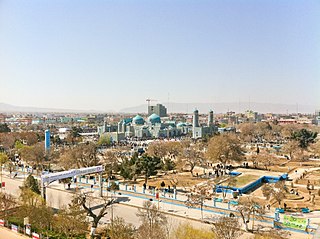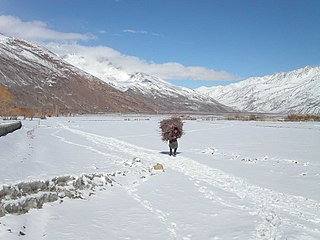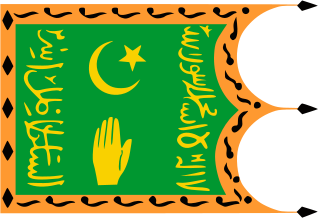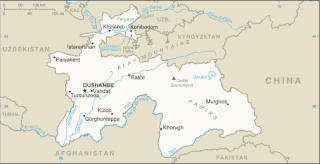
The Amu Darya is a major river in Central Asia and Afghanistan. Rising in the Pamir Mountains, north of the Hindu Kush, the Amu Darya is formed by the confluence of the Vakhsh and Panj rivers, in the Tigrovaya Balka Nature Reserve on the border between Afghanistan and Tajikistan, and flows from there north-westwards into the southern remnants of the Aral Sea. In its upper course, the river forms part of Afghanistan's northern border with Tajikistan, Uzbekistan, and Turkmenistan. In ancient history, the river was regarded as the boundary of Greater Iran with "Turan", which roughly corresponded to present-day Central Asia. The Amu Darya has a flow of about 70 cubic kilometres per year on average.

Central Asia is a region of Asia that stretches from the Caspian Sea in the west to western China and Mongolia in the east, and from Afghanistan and Iran in the south to Russia in the north. It includes the former Soviet republics of Kazakhstan, Kyrgyzstan, Tajikistan, Turkmenistan, and Uzbekistan, which are colloquially referred to as the "-stans" as the countries all have names ending with the Persian suffix "-stan", meaning "land of". Current geographical location of Central Asia was formerly part of the historic Turkistan also known as Turan.

Mazār-i-Sharīf, also called Mazār-e Sharīf, or just Mazār, is the fourth-largest city of Afghanistan, with a population estimate of 594,551 people. It is the capital of Balkh province and is linked by highways with Kunduz in the east, Kabul in the southeast, Herat in the southwest and Termez, Uzbekistan in the north. It is about 55 km (34 mi) from the Uzbek border. The city is also a tourist attraction because of its famous shrines as well as the Islamic and Hellenistic archeological sites. The ancient city of Balkh is also nearby.

Tajiks are a Persian-speaking Iranian ethnic group native to Central Asia, living primarily in Afghanistan, Tajikistan, and Uzbekistan. Tajiks are the largest ethnicity in Tajikistan, and the second-largest in Afghanistan and Uzbekistan. They speak varieties of Persian, a Western Iranian language. In Tajikistan, since the 1939 Soviet census, its small Pamiri and Yaghnobi ethnic groups are included as Tajiks. In China, the term is used to refer to its Pamiri ethnic groups, the Tajiks of Xinjiang, who speak the Eastern Iranian Pamiri languages. In Afghanistan, the Pamiris are counted as a separate ethnic group.

Bactria, or Bactriana, was an ancient region in Central Asia in Amu Darya's middle stream, stretching north of the Hindu Kush, west of the Pamirs and south of the Gissar range, covering the northern part of Afghanistan, southwestern Tajikistan and southeastern Uzbekistan.

The Fergana Valley in Central Asia lies mainly in eastern Uzbekistan, but also extends into southern Kyrgyzstan and northern Tajikistan.

Nikolai Ivanovich Vavilov was a Russian and Soviet agronomist, botanist and geneticist who identified the centers of origin of cultivated plants. He devoted his life to the study and improvement of wheat, maize and other cereal crops that sustain the global population.

Balkh is one of the 34 provinces of Afghanistan, located in the north of the country. It is divided into 15 districts and has a population of about 1,509,183, which is multi-ethnic and mostly a Persian-speaking society. The city of Mazar-i-Sharif serves as the capital of the province. The Mazar-e Sharif International Airport and Camp Marmal sit on the eastern edge of Mazar-i-Sharif.

Vahdat is a city in western Tajikistan, on the bank of the Kofarnihon River, 21 km east of Dushanbe. It was previously called Yangi-Bozor (1927–1936), Orjonikidzeobod and Kofarnihon (1993–2006). Its population is estimated at 43,200 for the city proper and 342,700 for the city with the outlying communities (2020). Vahdat was the focus on international attention in 2019 when a riot occurred in the city's prison, believed to be instigated by members of Islamic State, which led to the deaths of three guards and 29 inmates.

The Rasht Valley is located in Tajikistan and composes a significant portion of the Region of Republican Subordination, including the six districts of Lakhsh, Rasht, Roghun, Tavildara, Tajikobod and Nurabad. Historically the Rasht Valley has been called Karotegin or Karategin. During the 1992-1997 Tajikistan Civil War, the region was a stronghold for forces opposed to the government of Emomalii Rahmon and became the site of numerous battles. Notably, four members of the United Nations Mission of Observers in Tajikistan were murdered in the Garm district in 1998.

Khujand, sometimes spelled Khodjent and known as Leninabad from 1936 to 1991, is the second-largest city of Tajikistan and the capital of Tajikistan's northernmost Sughd province.

Wakhan, or "the Wakhan", is a rugged, mountainous part of the Pamir, Hindu Kush and Karakoram regions of Afghanistan. Wakhan District is a district in Badakshan Province.

Batken Region is a region (oblus) of Kyrgyzstan. Its capital is Batken. It is bounded on the east by Osh Region, on the south, west and north by Tajikistan, and on the northeast by Uzbekistan. The northern part of the region is part of the flat, agricultural Ferghana Valley. The land rises southward to the mountains on the southern border: the Alay Mountains in the east, and the Turkestan Range in the west. Its total area is 17,048 km2 (6,582 sq mi). The resident population of the region was 548,247 as of January 2021. The region has sizeable Uzbek and Tajik minorities.

The Emirate of Bukhara was a Muslim polity in Central Asia that existed from 1785 to 1920 in what is now modern-day Uzbekistan, Tajikistan, Turkmenistan and Kazakhstan. It occupied the land between the Amu Darya and Syr Darya rivers, known formerly as Transoxiana. Its core territory was the land along the lower Zarafshon river, and its urban centres were the ancient cities of Samarqand and the emirate's capital, Bukhara. It was contemporaneous with the Khanate of Khiva to the west, in Khwarazm, and the Khanate of Kokand to the east, in Fergana. In 1920, it ended with the establishment of the Bukharan People's Soviet Republic.

Soviet Central Asia was the part of Central Asia administered by the Soviet Union between 1918 and 1991, when the Central Asian republics declared independence. It is nearly synonymous with Russian Turkestan in the Russian Empire. Soviet Central Asia went through many territorial divisions before the current borders were created in the 1920s and 1930s.
Kaldar is a small district in the northern part of Balkh Province, Afghanistan. The northern and the eastern border of the district is the large Amu Darya river. North of the river is Uzbekistan and east is Tajikistan. The main village, also called Kaldar, is in the northeastern part of the district, close to the river. According to the inhabitants of this village, its original name is Kakoldar.
Terrorism in Tajikistan stems largely from the forces of the political opposition who opposed the comprehensive peace agreement that ended the civil war in 1997. President Emomali Rahmonov and UTO leader Said Abdullah Nuri signed the agreement on 27 June, believing it would bring an end to hostilities. However, dissident Islamist militants led by Tohir Yo‘ldosh and Juma Namangani formed the Islamic Movement of Uzbekistan in 1998, allying with Al-Qaeda and vowing to unite Central Asia as an Islamic state. The latest terror attacks took place in the Qabodiyon District on November 6, 2019, when a policeman and a border guard were killed by several Islamic State militants. 15 terroristi were also killed.
The Katagans are a medieval Mongol tribe related to Genghis Khan. In the period of Mongol conquest and assimilation with enslaved by Turkic tribes played its role in the ethnogenesis of modern Kazakhs, Kyrgyz, Karakalpaks, Uzbeks, Buryats, Uyghurs and others.

The border between Kyrgyzstan and Tajikistan is 984 kilometres (611 mi) long and runs from the tripoint with Uzbekistan to the tripoint with China.

Mikhail Stepanovich Andreyev was a Russian-Uzbek and Soviet orientalist, cultural researcher of Central Asia, ethnographer, linguist, and archaeologist. He was initially supervised by Vladimir Nalivkin, and was the teacher of Olga Alexandrovna Sukhareva. He was a corresponding member of the Russian Academy of Sciences.
















